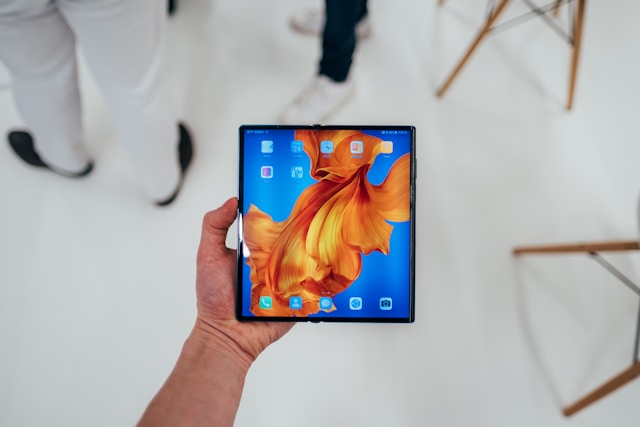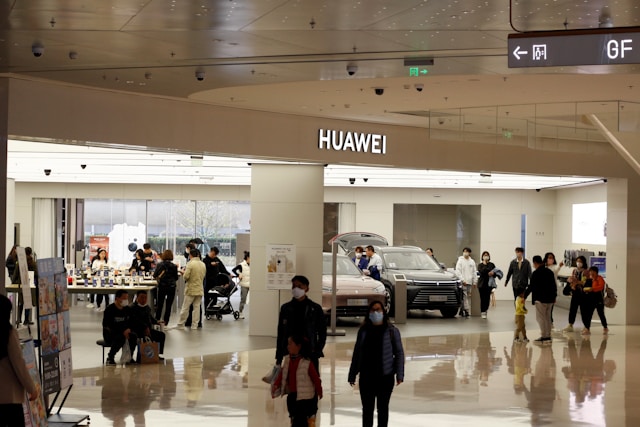Huawei, a leading global provider of information and communications technology (ICT) infrastructure and smart devices, has achieved remarkable growth and brand recognition in a competitive market. This success can be attributed to its innovative and dynamic marketing strategies that have helped it navigate challenges and capitalize on opportunities. This article will explore the key elements of Huawei’s marketing strategy, offering insights and inspiration for marketing professionals looking to learn from a big brand’s success story.
Building a Strong Brand Identity
Huawei’s marketing strategy starts with a robust brand identity that communicates its core values of innovation, quality, and global connectivity. The company has positioned itself as a forward-thinking brand that bridges the digital divide, aiming to bring technology to every person, home, and organization.
Global Campaigns: One of Huawei’s notable campaigns is the “Building a Fully Connected, Intelligent World” initiative. This campaign underscores Huawei’s commitment to innovation and connectivity, emphasizing its role in creating a smarter, more interconnected world. By focusing on a universal message, Huawei has been able to appeal to a broad audience across different regions and cultures.

Leveraging Influencer Partnerships
Influencer marketing has been a cornerstone of Huawei’s strategy, helping the brand connect with diverse audiences through trusted voices in the tech and lifestyle sectors. Collaborations with celebrities, tech influencers, and sports personalities have significantly boosted Huawei’s brand visibility and credibility.
Example: Huawei’s partnership with football superstar Lionel Messi stands out as a key example. Messi, known for his excellence and global appeal, became the face of Huawei’s global campaigns, including the promotion of the Huawei Mate series smartphones. This partnership not only enhanced Huawei’s brand image but also aligned it with values of excellence and perseverance, resonating with fans worldwide.
Innovative Product Launches
Huawei’s product launches are more than just events; they are meticulously crafted experiences designed to create buzz and excitement. The company invests heavily in high-profile launch events, often live-streamed to reach a global audience, ensuring maximum exposure and engagement.
Example: The launch of the Huawei P30 series was a prime example of this strategy. Held in Paris, the event showcased the smartphone’s advanced camera technology through immersive demonstrations and hands-on experiences. The event generated significant media coverage and social media buzz, positioning the P30 series as a game-changer in mobile photography.
Digital and Social Media Marketing
In the digital age, a strong online presence is crucial. Huawei has effectively utilized digital and social media platforms to engage with its audience, share content, and drive brand awareness. The company maintains active profiles on major social media platforms, including Facebook, Twitter, Instagram, and YouTube, where it shares product updates, promotional content, and customer stories.
Example: The #HuaweiNextImage campaign is a successful social media initiative that encouraged users to share photos taken with Huawei devices. This user-generated content campaign not only showcased the superior camera capabilities of Huawei smartphones but also fostered a sense of community among users, enhancing brand loyalty.
Commitment to Research and Development
Huawei’s commitment to research and development (R&D) is a fundamental aspect of its marketing strategy. By consistently investing in R&D, Huawei has positioned itself as a leader in innovation, developing cutting-edge technology that meets the evolving needs of consumers.
Example: The introduction of 5G technology is a testament to Huawei’s R&D prowess. As a pioneer in 5G development, Huawei has led the way in bringing faster, more reliable connectivity to markets worldwide. This leadership in 5G has been a key selling point in its marketing campaigns, highlighting Huawei’s role in shaping the future of technology.
Localized Marketing Approaches
While Huawei operates on a global scale, it recognizes the importance of localized marketing strategies to cater to specific regional markets. This approach involves tailoring marketing messages and campaigns to align with local cultures, preferences, and consumer behaviors.
Example: In China, Huawei has leveraged traditional Chinese values and local influencers to build a strong domestic presence. Campaigns often emphasize themes of family, community, and national pride, resonating deeply with Chinese consumers. This localized approach has helped Huawei maintain a dominant market share in its home country.

Strategic Sponsorships and Partnerships
Huawei has strategically aligned itself with various organizations and events to enhance its brand visibility and reach new audiences. These sponsorships and partnerships span sports, entertainment, and technology sectors, providing multiple touchpoints for consumer engagement.
Example: Huawei’s sponsorship of the ABSA Cape Epic, a renowned mountain bike race in South Africa, highlights its commitment to sports and outdoor activities. This sponsorship not only promotes Huawei’s brand but also associates it with endurance, adventure, and cutting-edge technology used in outdoor gear.
Emphasis on Customer Experience
A key differentiator in Huawei’s marketing strategy is its focus on providing an exceptional customer experience. From product design to after-sales service, Huawei strives to exceed customer expectations at every touchpoint. This commitment to quality and customer satisfaction is communicated consistently through its marketing efforts.
Example: The Huawei Service Day initiative, which offers free repair services and software updates at select service centers, exemplifies this focus on customer experience. By providing added value and ensuring customer satisfaction, Huawei strengthens its relationship with consumers and builds long-term loyalty.
Utilizing Data-Driven Marketing
Data-driven marketing is at the core of Huawei’s strategy. The company leverages data analytics to understand consumer preferences, monitor market trends, and optimize marketing campaigns. This approach enables Huawei to make informed decisions, personalize marketing messages, and improve campaign effectiveness.
Example: By analyzing data from its online platforms and consumer interactions, Huawei can identify emerging trends and adapt its marketing strategies accordingly. This agility allows the company to stay ahead of the competition and respond swiftly to changing market dynamics.
Corporate Social Responsibility (CSR)
Huawei’s marketing strategy also incorporates a strong focus on corporate social responsibility. The company actively engages in initiatives that promote sustainability, education, and community development. These efforts not only contribute to positive societal impact but also enhance Huawei’s brand reputation and consumer trust.
Example: The Seeds for the Future program is a flagship CSR initiative that provides training and development opportunities for young talent in the ICT sector. By investing in the next generation of tech leaders, Huawei demonstrates its commitment to social responsibility and positions itself as a brand that cares about future innovation.
Navigating Challenges and Controversies
Like any major corporation, Huawei has faced its share of challenges and controversies. The company’s marketing strategy includes proactive reputation management to address issues and maintain consumer trust. Transparent communication and a focus on facts have been key elements in navigating these challenges.
Example: In response to the geopolitical tensions and trade restrictions imposed by the US, Huawei launched the “Huawei Facts” website. This platform provides factual information and updates about the company’s operations, addressing misconceptions and reinforcing its commitment to transparency and integrity.
The Power of Storytelling
Storytelling is a powerful tool in Huawei’s marketing arsenal. By sharing compelling narratives about its products, innovations, and the impact of its technology, Huawei creates an emotional connection with its audience. These stories highlight the real-world benefits of Huawei’s solutions and inspire consumers to envision a better future through technology.
Example: The “StorySign” campaign, which uses AI technology to help deaf children learn to read, is a prime example of Huawei’s storytelling prowess. This heartwarming campaign not only showcases the potential of Huawei’s technology but also underscores its commitment to making a positive social impact.
5 Lessons Marketers Can Learn from Huawei’s Strategy
Huawei’s marketing strategy is a multifaceted approach that combines strong brand identity, innovative product launches, influencer partnerships, digital engagement, localized marketing, strategic sponsorships, and a commitment to customer experience and corporate social responsibility. By leveraging these elements, Huawei has successfully navigated challenges and capitalized on opportunities, achieving remarkable growth and brand recognition.
Marketing professionals can draw valuable lessons from Huawei’s strategy, such as the importance of innovation, the power of storytelling, the benefits of data-driven marketing, and the value of a customer-centric approach. As the marketing landscape continues to evolve, Huawei’s success story serves as an inspiring example of how a well-executed marketing strategy can drive business success and build a lasting brand legacy.
Here are five key lessons to draw from Huawei’s success:
1. Embrace Innovation and Invest in R&D
Lesson: Continuous investment in research and development (R&D) is crucial for staying ahead in a competitive market. Innovation drives product differentiation and brand prestige.
Example: Huawei’s substantial investment in 5G technology has positioned it as a leader in this emerging field. By prioritizing R&D, Huawei has been able to develop cutting-edge products and services that meet evolving consumer needs and set industry standards.
Takeaway for Marketers: Allocate resources to R&D to ensure your products or services remain relevant and ahead of the curve. Innovation not only attracts attention but also builds long-term customer loyalty.
2. Leverage Influencer and Celebrity Partnerships
Lesson: Collaborating with influencers and celebrities can significantly boost brand visibility and credibility. These partnerships can help reach new audiences and reinforce brand values.
Example: Huawei’s partnership with Lionel Messi has enhanced its global appeal. Messi’s association with the brand underscores values of excellence and perseverance, aligning with Huawei’s image of high performance and quality.
Takeaway for Marketers: Identify influencers or celebrities whose values align with your brand. Such partnerships can amplify your message, engage diverse demographics, and create a more relatable brand image.
3. Create Immersive and Memorable Product Launches
Lesson: Product launches should be more than just events; they should be immersive experiences that generate excitement and engagement. This approach can create buzz and drive media coverage.
Example: The launch of the Huawei P30 series in Paris was a meticulously planned event that highlighted the smartphone’s advanced camera technology. The event included interactive demonstrations, creating a memorable experience for attendees and viewers alike.
Takeaway for Marketers: Invest in creating unique and engaging product launch experiences. Utilize live streaming, interactive elements, and compelling narratives to captivate your audience and maximize coverage.
4. Adopt a Data-Driven Marketing Approach
Lesson: Leveraging data analytics can optimize marketing strategies, personalize customer interactions, and enhance campaign effectiveness. Data-driven decisions help in understanding consumer behavior and market trends.
Example: Huawei uses data from its online platforms and customer interactions to tailor its marketing efforts. This approach allows the company to respond swiftly to market changes and consumer preferences, ensuring its campaigns are relevant and effective.
Takeaway for Marketers: Use data analytics to inform your marketing strategies. Understanding your audience’s behavior and preferences can help you create more targeted and impactful campaigns.
5. Prioritize Customer Experience and Engagement
Lesson: A customer-centric approach is essential for building loyalty and sustaining long-term success. Exceptional customer service and engagement can differentiate your brand in a crowded market.
Example: Huawei’s Service Day initiative, offering free repairs and software updates, exemplifies its commitment to customer satisfaction. Such initiatives enhance the overall customer experience, fostering trust and loyalty.
Takeaway for Marketers: Focus on delivering a superior customer experience at every touchpoint. Engage with your customers regularly, listen to their feedback, and provide added value through exceptional service and support.

